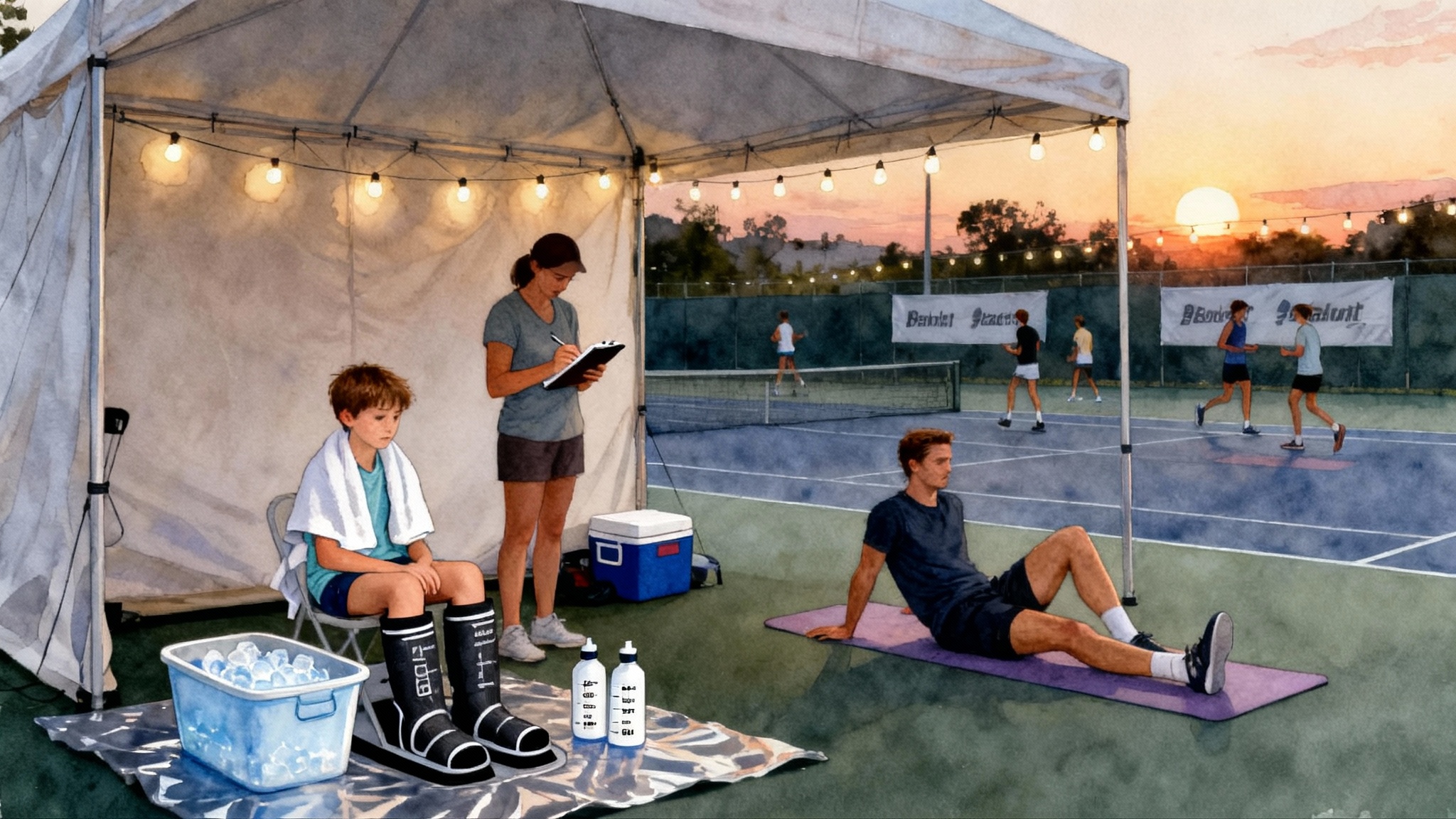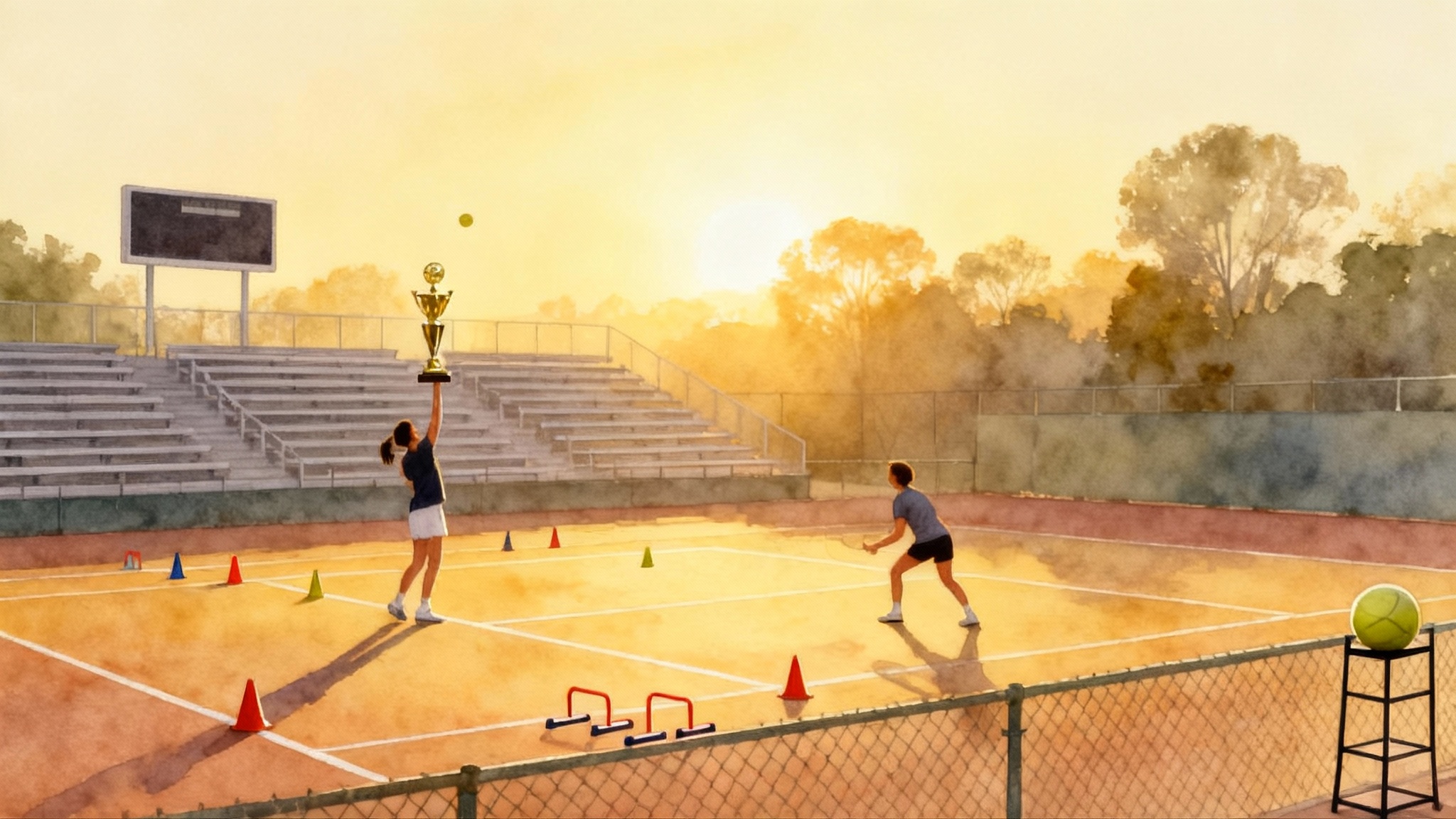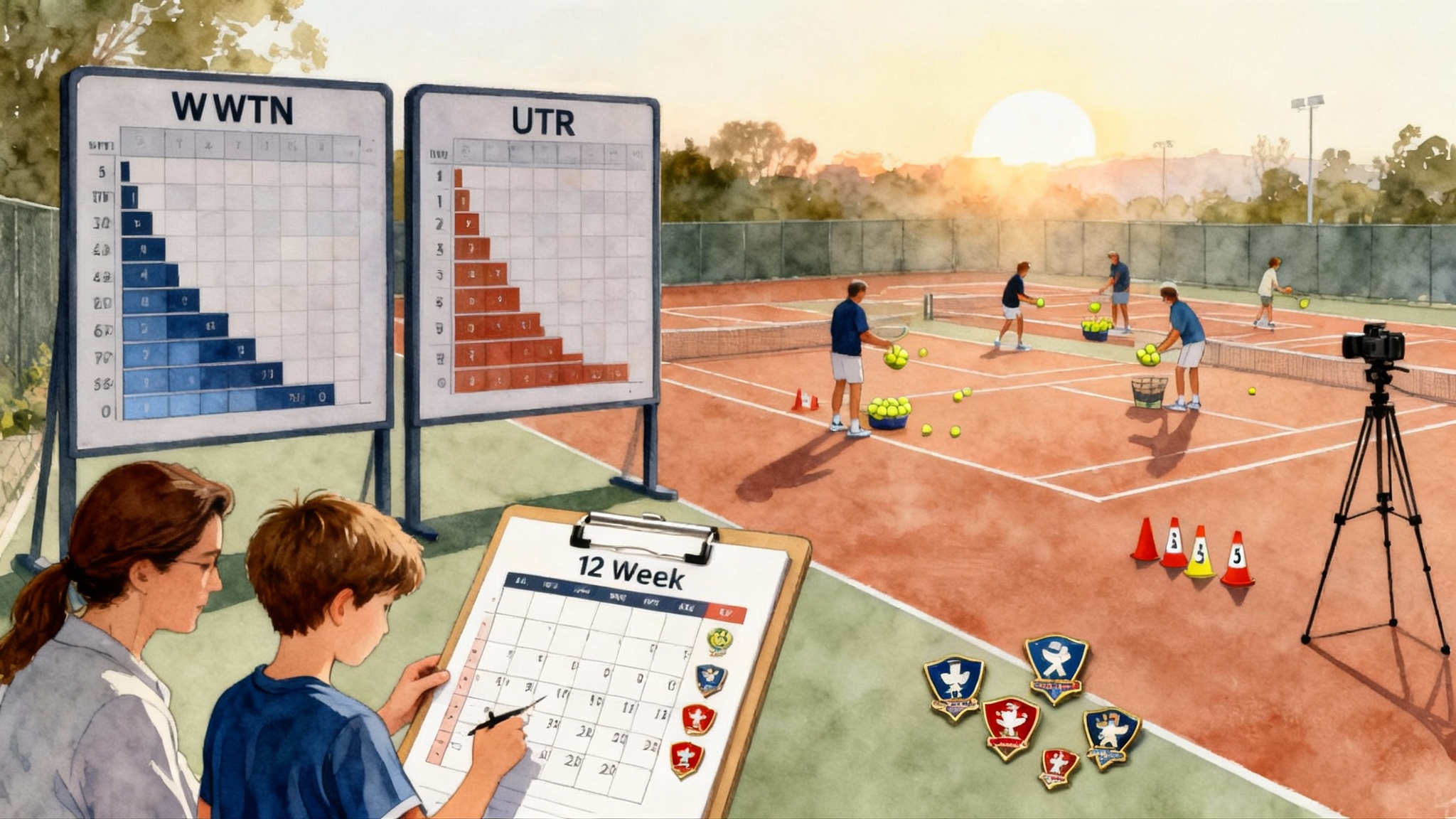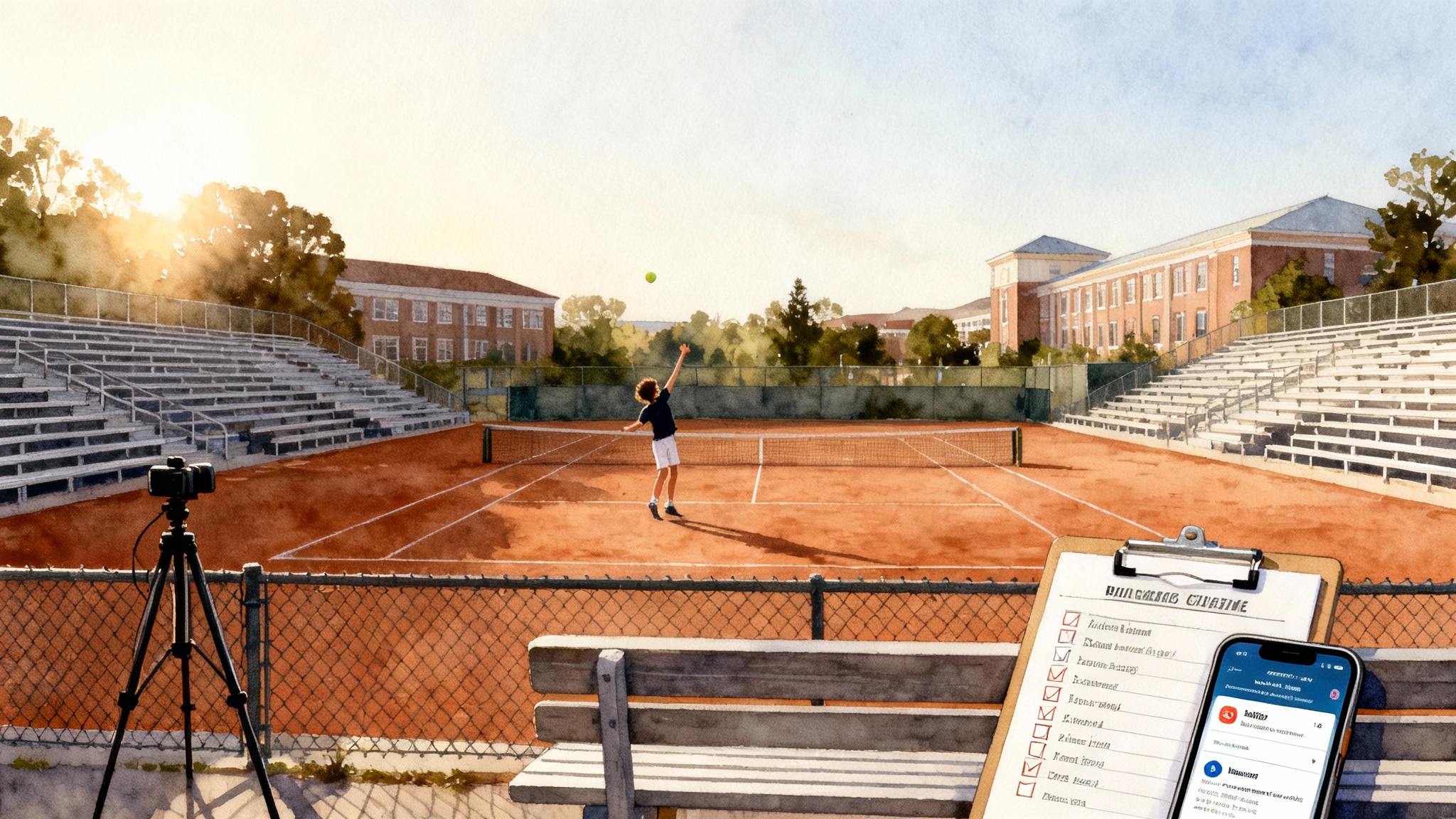Tournament Weekend Recovery: A 48-Hour Tennis Protocol
Back-to-back match days are won in the hours between them. Use this 48-hour step-by-step protocol for warm-downs, mobility, hydration, refueling, sleep, and morning activation. Includes parent checklists, adult templates, heat and travel tactics.

Why a 48-hour plan wins Monday, not just Sunday
Tournament weekends compress stress. You stack long rallies, sprints, serves, and decisions into a few hours, then ask your body and brain to reset overnight. Recovery is not a luxury. It is the bridge from the last point of today to the first point of tomorrow. A good protocol makes energy predictable, reduces soreness, and keeps decision making sharp.
Below is a practical, step-by-step 48-hour plan for juniors, parents, and adult competitors. It gives exact hydration and fueling targets, mobility flows you can do in a parking lot, sleep strategies that actually move the needle, and morning activation that makes your first three games feel like your third set. To sharpen your first step on match mornings, see split-step timing made simple.
The 48-hour tournament recovery protocol
The clock starts at handshake. Use a watch or phone timer and follow the windows.
0 to 15 minutes post-match
- Move, do not collapse: Walk 5 minutes at an easy pace while deep breathing through the nose. Goal: gently lower heart rate and keep blood moving.
- Warm-down circuit, 6 minutes total: 2 rounds of 30 seconds each of heel-to-glute sweeps, knee-to-chest walks, lateral shuffles, arm circles, and light skipping. This is circulation, not training.
- Start rehydrating: Sip 300 to 500 milliliters of fluid. If the match was hot or humid, include electrolytes. Aim for roughly 400 to 800 milliliters per hour during the next few hours, adjusting by thirst and body size.
15 to 45 minutes post-match
- Mobility reset, 8 to 10 minutes: Calf rocks, half-kneeling hip flexor stretch, 90-90 hip switches, thoracic spine open books, and wrist flexor and extensor stretches. Hold each position 20 to 30 seconds, move slowly, avoid pushing into pain.
- Refill glycogen: Eat 1 to 1.2 grams of carbohydrate per kilogram of body mass within the first hour. Add 20 to 30 grams of protein. Example: a 60 kilogram junior targets about 60 to 72 grams of carbohydrate plus 20 to 30 grams of protein. Choices: chocolate milk and a banana, rice bowl with chicken, yogurt with granola and berries, or a turkey wrap with pretzels.
- Replace sodium if you sweat heavily: A practical target is 500 to 1,000 milligrams of sodium across the next 2 to 3 hours if shirts are salt-stained or cramps occurred. This can come from sports drink, salted rice, broth, pickles, or an electrolyte tablet.
45 minutes to 3 hours post-match
- Keep sipping: Total fluid intake in this window should roughly match 125 to 150 percent of body mass lost in the match. Quick method: weigh before and after the match. Each 0.45 kilogram lost is about 500 to 750 milliliters to replace over the next few hours. Example: down 0.9 kilograms means a 1.1 to 1.35 liter replacement goal.
- Eat a balanced meal within 2 hours: 1 to 1.5 grams of carbohydrate per kilogram, 0.3 grams of protein per kilogram, some colorful produce, and a thumb of fat for satiety. Example for a 75 kilogram adult: 75 to 110 grams of carbohydrate, about 20 to 25 grams of protein, roasted vegetables, and olive oil or avocado.
- Compression and cold, if needed: If you have visible swelling, a short cold immersion or gentle compression can help with comfort. Limit cold exposure to the last match of the day to avoid blunting training adaptations earlier.
Evening before the next match
- Light shakeout, 10 minutes: Easy walk, band activation for glutes and shoulders, plus 10 gentle shadow swings each side. Stop if you feel any sharp pain.
- Dinner timing: Finish 2 to 3 hours before bedtime. Include carbohydrate to top off glycogen, protein to support tissue repair, and salt if the day was sweaty. Think rice, salmon, a large salad with olive oil and feta, and sourdough bread with butter and salt.
- Pre-sleep snack: 30 to 40 grams of slow-digesting protein if you struggle with soreness. Cottage cheese or Greek yogurt works. Keep fiber and spice low to avoid gut upset.
- Sleep environment: Cool room around 65 to 68 degrees Fahrenheit, dark, and quiet. Hot shower or bath 60 to 90 minutes before bed helps you fall asleep by lowering core temperature afterward. Put your phone to night mode and cap caffeine by early afternoon.
Match morning activation
- Wake hydration: 300 to 500 milliliters of fluid within 30 minutes of waking. Add electrolytes if the day will be hot or if your urine is dark.
- Breakfast 2 to 3 hours pre-match: 1 to 2 grams of carbohydrate per kilogram and 20 to 30 grams of protein. Choose easy-to-digest foods. Examples: oatmeal with honey and banana plus eggs, or toast with peanut butter and a yogurt.
- Neural and joint wake-up, 12 minutes: Ankle rocks, hip circles, cat-cow spine, band external rotations, skipping, A-skips, three short accelerations of 10 to 15 meters, 10 shadow serves. Finish with 2 minutes of diaphragmatic breathing to steady nerves.
After the final match of the weekend
- Repeat immediate warm-down and fueling: If soft tissue is tender or swollen, 6 to 8 minutes of cold immersion between 10 and 12 degrees Celsius can help comfort. Keep it short and warm up afterward.
- Next 24 hours: Aim for 1.5 times normal daily fluids, steady salts in meals, and 3 balanced meals plus snacks. Keep walking lightly for circulation. Gentle mobility twice daily for 8 minutes reduces stiffness.
Parent checklists for junior events
Pack with a system, not hope. Use these checklists the night before. If college tennis is on the radar, review our WTN vs UTR 2025 guide to align tournament choices.
Cooler and hydration
- Fluids: Two liters of water per player plus 1 liter of electrolyte mix. For hot days, double the electrolyte volume.
- Tracking: Measuring marks on bottles to track intake. A fine-tip marker and masking tape works.
- Scale: Small travel scale in a zip bag to monitor pre and post-match body mass when possible.
Fuel and snacks
- Simple carbohydrates: Bananas, applesauce pouches, fig bars, pretzels, rice cakes.
- Protein options: Greek yogurt, string cheese, turkey wraps, chocolate milk, shelf-stable tuna packs.
- Salt sources: Broth packets, salted crackers, pickles.
- Post-match meal kit: Pre-cooked rice, rotisserie chicken, microwavable vegetables.
Recovery tools
- Basics: Two towels, a lacrosse ball, a short resistance band, a mini foam roller, and a pair of compression socks.
- Cooling: Two cold packs in a soft cooler sleeve for hot days.
- Sun protection: Sunscreen, hat, and a light long-sleeve shirt for sun protection between matches.
Admin and monitoring
- Log the basics: Printed match times and a simple log: sleep hours, urine color check on waking, morning resting heart rate, perceived soreness 1 to 10. Patterns guide decisions.
- HRV optional: If you use it, take the measure on waking, seated, and compare to a 7-day personal average, not a single-day spike.
Templates for self-coached adults
You do not need a staff to recover like a pro. Pick the template that matches your weekend. In off weeks, build robustness with this 12-week tennis strength blueprint.
League doubleheader template
- Between matches: 10-minute walk, mobility reset, 500 milliliters of fluid with electrolytes, 60 to 80 grams of carbohydrate plus 20 grams of protein, feet up for 15 minutes.
- Evening: Dinner with 1 gram of carbohydrate per kilogram and 0.3 grams of protein per kilogram, salted. Hot shower 60 minutes before bed, screens off 30 minutes before.
- Morning: 300 milliliters fluid on waking, breakfast 2 hours pre-match, 12-minute activation.
Tournament draw with unknown start times
- Flexible fueling ladder: If you are 3 hours out, eat a full meal. If you are 90 minutes out, eat a snack of 40 to 60 grams of carbohydrate with some protein. If you are 30 minutes out, sip a carbohydrate drink and avoid heavy foods.
- Bag staged in layers: Top flap for mobility tools and snacks, middle for towels and shirt changes, bottom for shoes and socks.
Masters or returning-from-injury template
- Extra mobility: Add one extra mobility block midday and switch afternoon jogging to a 10-minute gentle spin on a stationary bike if available.
- Compression focus: Cap cold immersion at the final match only. Use compression socks for the evening and a 20-minute legs-up-the-wall position for venous return.
Heat and humidity adjustments
Hot and humid conditions change the math.
- Shorten warm-ups: Reduce by 20 to 30 percent and save the extra intensity for the first two changeovers.
- Pre-cool: 10 minutes with ice towels on the neck and forearms or a slushy ice drink before heading to the court.
- Fluid replacement: Replace at 125 to 150 percent of body mass lost. Practical cue: for every 0.45 kilogram lost, drink 500 to 750 milliliters over the next few hours.
- Increase sodium: Heavy salt sweaters can aim for 1,500 to 2,500 milligrams across the day around matches. Spread this across drinks and meals to protect the stomach.
- Use shade and airflow: Between matches, remove shoes and socks to air feet if the surface is dry, then re-tape if needed to prevent blisters.
Travel-day tactics that protect your next round
How you travel is part of recovery.
- Car trips: Stop every 60 to 90 minutes for a 3-minute walk, 10 calf raises, 10 hip hinges, and 10 arm circles. Keep a seat-back cushion to reduce low back stiffness.
- Flights: Choose an aisle seat when possible, stand during boarding and after drink service for a 2-minute stretch, wear light compression socks, and keep a soft bottle to sip 200 milliliters every 30 to 45 minutes.
- Timing: Avoid heavy novel foods the night before a match. Plan arrival so you can finish dinner 2 to 3 hours before bed.
- Light exposure: Morning sunlight for 10 minutes anchors your body clock after travel. Dim lights an hour before bed.
Sample menus and exact quantities
Use body mass to size meals. Adjust if you feel heavy or hungry in warm-ups.
60 kilogram junior, hot day with two matches
- Breakfast 2.5 hours pre-match: 90 grams carbohydrate, 20 grams protein, low fiber. Example: oatmeal with honey and banana, two eggs, water with electrolytes.
- Between matches: 60 to 70 grams carbohydrate and 15 to 20 grams protein. Example: turkey wrap, pretzels, small yogurt.
- Post-day dinner: 75 to 90 grams carbohydrate, 25 grams protein, vegetables, extra salt. Example: rice, chicken teriyaki, steamed broccoli, miso soup.
- Fluids: Target 1.5 to 2.0 liters during the competitive block plus 1.0 liter in the evening, adjusted by sweat loss.
75 kilogram adult, one long singles and one doubles
- Breakfast 3 hours pre-match: 120 grams carbohydrate, 25 to 30 grams protein. Example: bagel with peanut butter and honey, Greek yogurt with berries.
- In-play intake: 30 to 60 grams carbohydrate per hour if your gut tolerates it, via sports drink or chews. Test this in practice first.
- Recovery meal: 90 to 110 grams carbohydrate, 25 to 30 grams protein, moderate fat, extra salt. Example: rice bowl with steak, salsa, avocado, and tortilla chips.
- Evening snack: 30 grams protein, low fiber. Example: cottage cheese with pineapple.
Easy substitutions if your stomach is touchy
- Dairy swaps: Lactose-free options or soy yogurt.
- Carb swaps: Choose rice and potatoes over dense breads when nerves are high.
- Sodium gentler options: Use broth and salted rice if sports drinks feel too sweet.
Red flags that need a physio or physician
Stop guessing and get help if you notice any of the following.
- Bone stress signs: Sharp, localized pain that worsens with weight bearing, especially over bone, or pain that changes your gait.
- Joint issues: Swelling that does not settle overnight or locks, clicks, or gives way.
- Neurologic signs: Numbness, tingling, or weakness in the arm or hand after serving or overheads.
- Heat illness: Headache with confusion, nausea, goosebumps in the heat, or chills despite high temperature.
- Urine and cramps: Dark brown urine, very low urine output, or persistent cramping that does not improve with fluids and salts.
- Cardiac symptoms: Chest discomfort, unexplained shortness of breath, or palpitations. Seek urgent care.
Spotlight: a model at-home workflow inspired by academy setups
Families often ask what a professional academy recovery station looks like. Many high-performing programs organize recovery into three stations you can copy at home.
- Compression station
- Purpose: gentle external pressure to encourage venous return after heavy days.
- Home setup: a pair of graduated compression socks for the evening or a consumer compression boot system for 15 to 20 minutes at low to moderate pressure while reading or scouting.
- Cold and contrast station
- Purpose: comfort and swelling management after the final match of the day.
- Home setup: a short cold bath or tub with ice, 6 to 8 minutes at 10 to 12 degrees Celsius, followed by a warm shower. Use only after the last competitive effort, not between practice sessions where you want adaptation.
- Monitoring station
- Purpose: keep decisions objective across a long weekend.
- Home setup: morning measures before breakfast and screens. Record resting heart rate, simple subjective markers like sleep hours and muscle soreness, and one heart rate variability reading if you use a chest strap or finger sensor. Use a 7-day rolling average to judge dips instead of single-day changes.
The point is not to buy every device. It is to create a routine that makes the right choice easy and repeatable under stress.
Frequently asked friction points
I have two matches on the same day. Do I still eat a big meal between them?
Yes, but size it to time. More than 2 hours gap means a full meal. Ninety minutes means a lighter meal or a large snack. Less than an hour means liquid or soft carbohydrates plus electrolytes.
I cramp even when I drink a lot of water.
Cramps often track with sodium loss and rapid fatigue. Add 500 to 1,000 milligrams of sodium over the match block and ensure you are not under-fueling carbohydrate. Practice your in-play plan during hard sessions, not for the first time at a tournament.
My athlete cannot sleep after late matches.
Protect the wind-down. A hot shower 60 to 90 minutes pre-bed, a small protein snack, lights low, and a paper book can help. Avoid doom scrolling. If caffeine was used late, cut it earlier the next day.
The take-home map
- Move for 10 minutes after the handshake with light walking and a short warm-down.
- Replace fluids based on body mass change, and spread sodium across drinks and meals.
- Refuel within 60 minutes, then eat a balanced meal within 2 hours.
- Prioritize sleep in a cool, dark room with a consistent pre-bed routine.
- Activate in the morning with 12 minutes of joint prep, skips, accelerations, and shadow swings.
- Adjust for heat with pre-cooling, higher sodium, and shorter warm-ups.
- Keep a simple log and treat red flags promptly.
Tournament weekends reward the organized. With a clear 48-hour plan, you leave less to chance and more to your legs, lungs, and mind. Recovery becomes part of your game, not an afterthought. That is how you carry Sunday momentum into Monday training, ready for the next draw.


